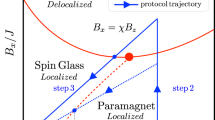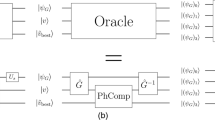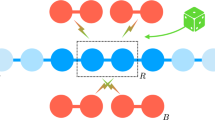Abstract
The physical properties of a quantum many-body system in thermal equilibrium are determined by its partition function and free energy. Here we study the computational complexity of approximating these quantities for n-qubit local Hamiltonians. First, we report a classical algorithm with poly(n) runtime, which approximates the free energy of a given 2-local Hamiltonian provided that it satisfies a certain denseness condition. Our algorithm contributes to a body of work investigating the hardness of approximation for difficult optimization problems. Specifically, this extends existing efficient approximation algorithms for dense instances of the ground energy of 2-local quantum Hamiltonians and the free energy of classical Ising models. Second, we establish polynomial-time equivalence between the problem of approximating the free energy of local Hamiltonians and several other natural tasks ubiquitous in condensed-matter physics and quantum computing, such as the problem of approximating the number of input states accepted by a polynomial-size quantum circuit. These results suggest that the simulation of quantum many-body systems in thermal equilibrium may precisely capture the complexity of a broad family of computational problems that have yet to be defined or characterized in terms of known complexity classes. Finally, we summarize state-of-the-art classical and quantum algorithms for approximating the free energy and show how to improve their runtime and memory footprint.
This is a preview of subscription content, access via your institution
Access options
Access Nature and 54 other Nature Portfolio journals
Get Nature+, our best-value online-access subscription
$29.99 / 30 days
cancel any time
Subscribe to this journal
Receive 12 print issues and online access
$209.00 per year
only $17.42 per issue
Buy this article
- Purchase on Springer Link
- Instant access to full article PDF
Prices may be subject to local taxes which are calculated during checkout

Similar content being viewed by others
Data availability
No dataset was generated or analysed, and no code was produced during the course of this study.
References
Kitaev, A. Y., Shen, A. H. & Vyalyi, M. N. Classical and Quantum Computation (American Mathematical Society, 2002).
Dinur, I. The PCP theorem by gap amplification. J. ACM 54, 12–es (2007).
Alimonti, P. & Kann, V. Hardness of approximating problems on cubic graphs. In Italian Conference on Algorithms and Complexity 288–298 (Springer, 1997).
Suzuki, M. Quantum Monte Carlo Methods in Condensed Matter Physics (World Scientific, 1993).
Barvinok, A. Combinatorics and Complexity of Partition Functions Vol. 9 (Springer, 2016).
Harrow, A. W., Mehraban, S. & Soleimanifar, M. Classical algorithms, correlation decay, and complex zeros of partition functions of quantum many-body systems. In Proc. 52nd Annual ACM SIGACT Symposium on Theory of Computing 378–386 (ACM, 2020).
Bravyi, S., Divincenzo, D. P., Oliveira, R. I. & Terhal, B. M. The complexity of stoquastic local Hamiltonian problems. Quant. Inf. Comp. vol. 8, no. 5, pp. 0361-0385 (2008).
Crosson, E. & Harrow, A. W. Rapid mixing of path integral Monte Carlo for 1D stoquastic Hamiltonians. Quantum 5, 395 (2021).
Bravyi, S. & Gosset, D. Polynomial-time classical simulation of quantum ferromagnets. Phys. Rev. Lett. 119, 100503 (2017).
Kuwahara, T., Kato, K. & Brandão, F. G. S. L. Clustering of conditional mutual information for quantum Gibbs states above a threshold temperature. Phys. Rev. Lett. 124, 220601 (2020).
Risteski, A. How to calculate partition functions using convex programming hierarchies: provable bounds for variational methods. In 29th Annual Conference on Learning Theory (eds. Feldman, V., Rakhlin, A. & Shamir, O.) vol. 49 of Proceedings of Machine Learning Research 1402–1416 (PMLR, 2016).
Yoshida, Y. & Zhou, Y. Approximation schemes via Sherali-Adams hierarchy for dense constraint satisfaction problems and assignment problems. In Proc. 5th Conference on Innovations in Theoretical Computer Science ITCS ’14 423–438 (ACM, 2014).
Bertsimas, D. & Vempala, S. Solving convex programs by random walks. J. ACM 51, 540–556 (2004).
Grötschel, M., Lovász, L. & Schrijver, A. Geometric Algorithms and Combinatorial Optimization Vol. 2 (Springer Science & Business Media, 2012).
Barak, B., Raghavendra, P. & Steurer, D. Rounding semidefinite programming hierarchies via global correlation. IEEE 52nd Annual Symposium on Foundations of Computer Science, pp. 472-481 (2011).
Brandao, F. G. & Harrow, A. W. Product-state approximations to quantum ground states. In Proc. Forty-Fifth Annual ACM Symposium on Theory of Computing STOC ’13 871–880 (ACM, 2013).
Gharibian, S. & Kempe, J. Approximation algorithms for QMA-complete problems. SIAM J. Comput. 41, 1028–1050 (2012).
Brandão, F. G. S. L. Entanglement Theory and the Quantum Simulation of Many-Body Physics. PhD thesis, Imperial College of Science, Technology and Medicine (2008).
Cade, C. & Montanaro, A. The quantum complexity of computing Schatten p-norms. In 13th Conference on the Theory of Quantum Computation, Communication and Cryptography (TQC 2018) (Schloss Dagstuhl--Leibniz-Zentrum fuer Informatik 2018).
Chowdhury, A. N., Somma, R. D. & Subasi, Y. Computing partition functions in the one-clean-qubit model. Phys. Rev. A 103, 032422 (2021).
Knill, E. & Laflamme, R. Power of one bit of quantum information. Phys. Rev. Lett. 81, 5672 (1998).
Stockmeyer, L. The complexity of approximate counting. In Proc. Fifteenth Annual ACM Symposium on Theory of Computing STOC ’83 118–126 (ACM, 1983).
Goldberg, L. A. & Guo, H. The complexity of approximating complex-valued Ising and Tutte partition functions. comput. complex. 26, 765–833 (2017).
Aharonov, D., Ben-Or, M., Brandao, F. G. & Sattath, O. The pursuit for uniqueness: extending Valiant-Vazirani theorem to the probabilistic and quantum settings. Quantum 6, 668 (2022).
Cubitt, T. S., Montanaro, A. & Piddock, S. Universal quantum Hamiltonians. Proc. Natl Acad. Sci. USA 115, 9497–9502 (2018).
Zhou, L. & Aharonov, D. Strongly universal Hamiltonian simulators. Preprint at https://arxiv.org/abs/2102.02991 (2021).
Kohler, T., Piddock, S., Bausch, J. & Cubitt, T. Translationally-invariant universal quantum Hamiltonians in 1D. Annales Henri Poincaré Vol. 23, pp. 223–254 (2022).
Kohler, T., Piddock, S., Bausch, J. & Cubitt, T. General conditions for universality of quantum Hamiltonians. PRX Quantum 3, 010308 (2022).
Gosset, D. & Smolin, J. A compressed classical description of quantum states. In 14th Conference on the Theory of Quantum Computation, Communication and Cryptography (TQC 2019) (Schloss Dagstuhl–Leibniz-Zentrum fuer Informatik, 2019).
Huang, H.-Y., Kueng, R. & Preskill, J. Predicting many properties of a quantum system from very few measurements. Nat. Phys. 16, 1050–1057 (2020).
Cleve, R., Leung, D., Liu, L. & Wang, C. Near-linear constructions of exact unitary 2-designs. Quant. Info. Comp. vol. 16, no. 9–10 pp. 721–756 (2016).
Dankert, C., Cleve, R., Emerson, J. & Livine, E. Exact and approximate unitary 2-designs and their application to fidelity estimation. Phys. Rev. A 80, 012304 (2009).
Hutchinson, M. F. A stochastic estimator of the trace of the influence matrix for Laplacian smoothing splines. Commun. Stat. Simul. Comput. 18, 1059–1076 (1989).
Meyer, R. A., Musco, C., Musco, C. & Woodruff, D. P. Hutch++: optimal stochastic trace estimation. In Symposium on Simplicity in Algorithms (SOSA) 142–155 (SIAM, 2021).
Poulin, D. & Wocjan, P. Sampling from the thermal quantum Gibbs state and evaluating partition functions with a quantum computer. Phys. Rev. Lett. 103, 220502 (2009).
Chowdhury, A. N. & Somma, R. D. Quantum algorithms for Gibbs sampling and hitting-time estimation. Quant. Inf. Comp. 17, 41–64 (2017).
Gilyén, A., Su, Y., Low, G. H. & Wiebe, N. Quantum singular value transformation and beyond: exponential improvements for quantum matrix arithmetics. In Proc. 51st Annual ACM SIGACT Symposium on Theory of Computing 193–204 (ACM, 2019).
van Apeldoorn, J., Gilyén, A., Gribling, S. & de Wolf, R. Quantum SDP-solvers: better upper and lower bounds. Quantum 4, 230 (2020).
Marriott, C. & Watrous, J. Quantum Arthur–Merlin games. Comput. Complex. 14, 122–152 (2005).
Kempe, J., Kitaev, A. & Regev, O. The complexity of the local Hamiltonian problem. SIAM J. Comput. 35, 1070–1097 (2006).
Brassard, G., Høyer, P., Mosca, M. and Tapp, A. Quantum amplitude amplification and estimation. In Quantum Computation and Information Vol. 305 of Contemporary Mathematics 53–74 (AMS, 2002).
Aaronson, S. and Rall, P. Quantum approximate counting, simplified. In Symposium on Simplicity in Algorithms 24–32 (SIAM, 2020).
Bravyi, S. & Maslov, D. Hadamard-free circuits expose the structure of the Clifford group. IEEE Trans. Inf. Theory 67, 4546–4563 (2021).
Acknowledgements
D.G. thanks B. Fefferman, S. Gharibian and R. Kothari for discussions about QAC. S.B., A.C. and D.G. are supported in part by the Army Research Office under grant no. W911NF-20-1-0014. D.G. is a CIFAR Fellow in the quantum information science program, and is also supported in part by IBM Research. Research at the Perimeter Institute is supported in part by the Government of Canada through the Department of Innovation, Science and Economic Development Canada and by the Province of Ontario through the Ministry of Colleges and Universities. S.B. is supported in part by the IBM Research Frontiers Institute.
Author information
Authors and Affiliations
Contributions
All authors contributed equally to the technical content and writing of the manuscript.
Corresponding author
Ethics declarations
Competing interests
The authors declare no competing interests.
Peer review
Peer review information
Nature Physics thanks Tamara Kohler, Ãngela Capel and the other, anonymous, reviewer(s) for their contribution to the peer review of this work.
Additional information
Publisher’s note Springer Nature remains neutral with regard to jurisdictional claims in published maps and institutional affiliations.
Supplementary information
Supplementary Information
Supplementary Sections 1–4.
Rights and permissions
Springer Nature or its licensor holds exclusive rights to this article under a publishing agreement with the author(s) or other rightsholder(s); author self-archiving of the accepted manuscript version of this article is solely governed by the terms of such publishing agreement and applicable law.
About this article
Cite this article
Bravyi, S., Chowdhury, A., Gosset, D. et al. Quantum Hamiltonian complexity in thermal equilibrium. Nat. Phys. 18, 1367–1370 (2022). https://doi.org/10.1038/s41567-022-01742-5
Received:
Accepted:
Published:
Issue Date:
DOI: https://doi.org/10.1038/s41567-022-01742-5



